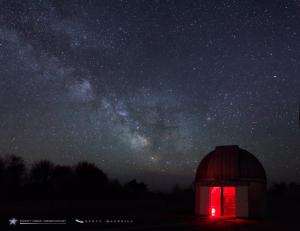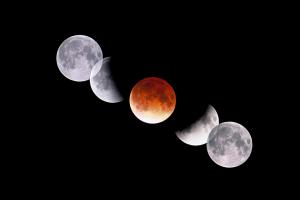
Stargazing Night
- Where:
- Frosty Drew Observatory
- When:
- Friday September 25, 2015 at 7:00 p.m.
- Cost:
- $1 Suggested Donation per Person
Tonight's forecast is calling for partly cloudy to mostly cloudy skies, making for an unfortunate change from what we have seen almost every night lately. The 91% waxing gibbous Moon will be with us for most of the night and will significantly brighten up the sky. With tonight's somewhat cloudy forecast, the bright Moon may be our viewing redemption as it's quite visible through thin cloud cover and in between passing clouds. Tonight could pan out for us though right now it is still looking questionable.
We'll open the Observatory and Sky Theatre at 7:00 p.m. tonight. In the Observatory we will try for a twilight viewing of Saturn. Once darkness sets in, we will either frequent binary stars or the bright gibbous Moon, depending on sky conditions. The Sky Theatre is open and will feature an astrophotography showcase shot at Frosty Drew Observatory. We will stay on site until 11:30 p.m. or until clouds chase us out, whichever comes first.
Our sky viewing forecast is not looking too promising, though attempts will certainly be had. The Moon should surely pop in and out of passing clouds enough to catch some great views of the cratered lunar surface. Following Frosty Drew Observatory on Twitter (@FrostyDrewOBSY) or Facebook will get you updates on conditions at the Observatory. We will post a “Closing up” update when we decide to pack it in. So take a moment to stop in tonight and catch a view of the Moon. Clouds begone!
-------------------------------------------------------------------------
Weekly Happenings
Scott MacNeill
This coming Sunday night (September 27th), a fabulous total lunar eclipse is happening. Hailed the Supermoon Eclipse, this lunar eclipse will coincide with the annual lunar perigee, known as the Supermoon. Additionally, this eclipse is the last total lunar eclipse of the current lunar tetrad, which is four total lunar eclipses in a row. Add in that this is the last total lunar eclipse until January 2018 (January 2019 for New England), and this is an event we don't want to miss out on.
The full Moon closest to the Autumnal Equinox is commonly called the “Harvest Moon”. Since the Equinox happened this past Wednesday morning at 4:21 a.m. EDT and a lunar eclipse can only happen during a full lunar phase, this eclipse is also the September Harvest Moon. Though commonly thought of as a super bright Moon, the Harvest Moon is really no different than any other full Moon aside from the time of year it happens.
Sunday's lunar eclipse will also be the annual Supermoon. When a full lunar phase occurs within 24 hours of the monthly lunar perigee, it is loosely referred to as a “Supermoon”. By that definition, we will experience about three Supermoons every year. The Moon has an elliptical orbit around Earth, called eccentricity, and takes about 27 days to complete one full orbit. This will result in the Moon having a closest point (perigee) and furthest point (apogee) in its monthly orbit. This difference varies about 30,000 miles in distance. Though one of the three Supermoons will be the closest for the year. The full Moon for September occurs on September 27th at 10:50 p.m. EDT and the lunar perigee for the month will occur on September 27th at 9:55 p.m. EDT. At a distance of 221,756 miles, it will be the closest of all full Moon's of the year. So Supermoon!
The lunar eclipse this weekend is also the final lunar eclipse of the current lunar tetrad. A lunar tetrad occurs when four total eclipses happen consecutively. We generally see two lunar eclipses each year, though sometimes up to four. An eclipse occurs when the Moon passes into Earth's shadows. The “penumbra” is Earth's secondary shadow where a significant amount of sunlight is still visible. The “umbra” is Earth's primary shadow, where most sunlight is obscured. Not all lunar eclipses are total eclipses, we also have partial lunar eclipses (only part of the Moon passes into Earth's umbra), and penumbral lunar eclipses (when the Moon passes into Earth's penumbra only). Sunday's eclipse will be the last total lunar eclipse of four in a row, with the previous total lunar eclipses happening on April 15, 2014, October 8, 2014, and April 4, 2015. Lunar tetrads are often considered rare occurrences, though not entirely. We see about 8 lunar tetrads per century. Somewhat cyclical, lunar tetrads will have a 300 year period showing frequent tetrads, followed by a 300 year period with few to no tetrads.
Viewing the lunar eclipse will be cake. All you need is a view of the Moon! The eclipse will begin at 8:11 p.m. EDT when the Moon passes into Earth's penumbra. At 9:07 p.m. EDT the Moon will enter Earth's umbra. This is when the eclipse will become quite visible as a portion of the Moon begins to disappear. At 10:11 p.m. EDT the Moon will drop completely into Earth's umbra. This is called totality, or total eclipse. Maximum eclipse will happen at 10:47 p.m. EDT, which will be the point when the Moon is at the most center point of Earth's umbra. Total eclipse will continue until 11:23 p.m. EDT, when the Moon starts to emerge from Earth's umbra. Partial eclipse will continue until 12:27 a.m. EDT at which point the eclipse is largely over from a visibility standpoint. Penumbral eclipse will continue until 1:22 a.m. EDT, which will mark the end of the eclipse. Frosty Drew will be open for the entire eclipse and will welcome any visitors who wish to observe the event with us. Read about it.
Whatever your reason for getting into the eclipse, one this is certain. It is a fabulous celestial event that we as members of planet Earth get to experience. Some like to find doomsday hoaxes and fear mongering predictions to assign to these life-enriching events and sadly enough, many people embrace these fallacies. I say pay no attention to such nonsense and get out and enjoy this fabulous view of the natural world and the processes that make planet Earth an awesome place for life to thrive.
-Scott


